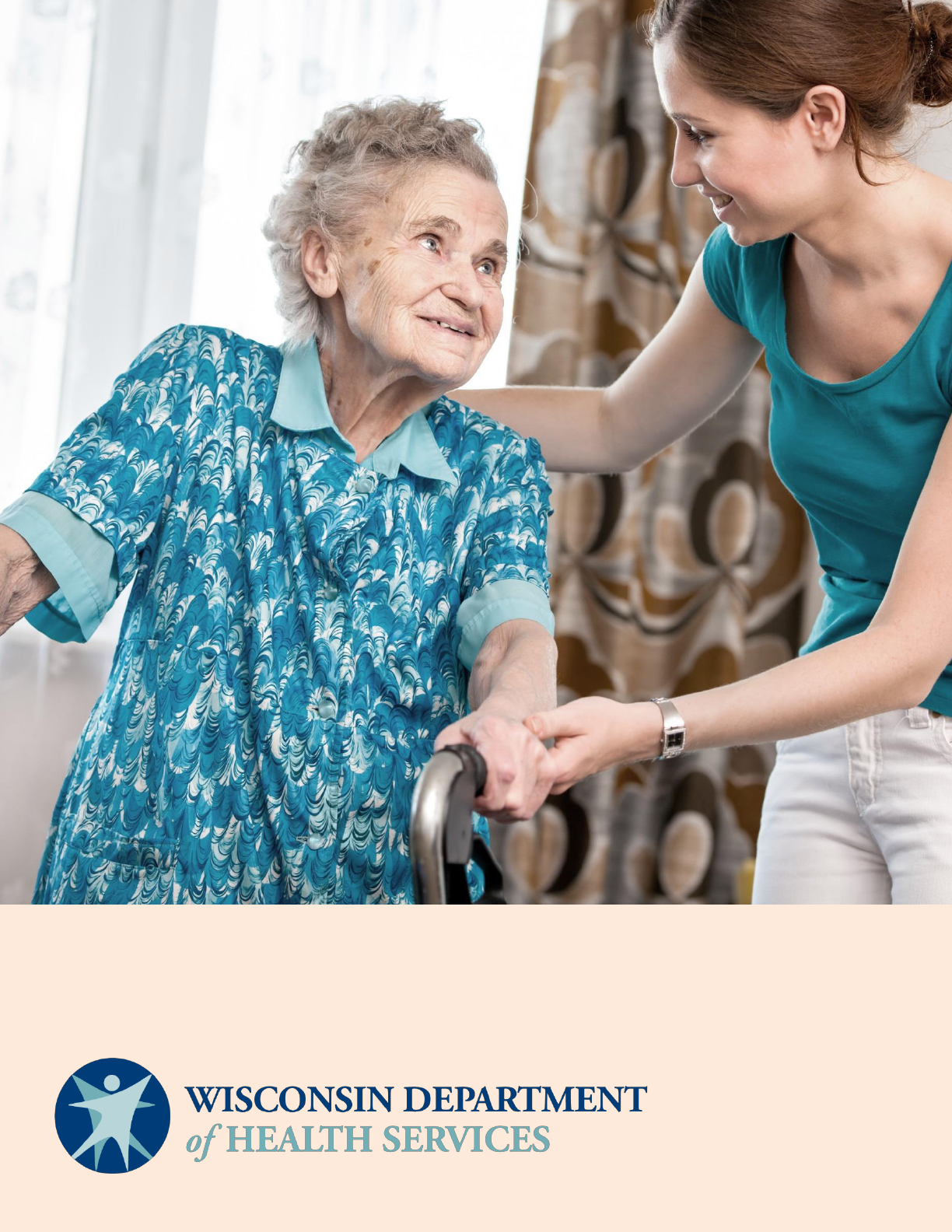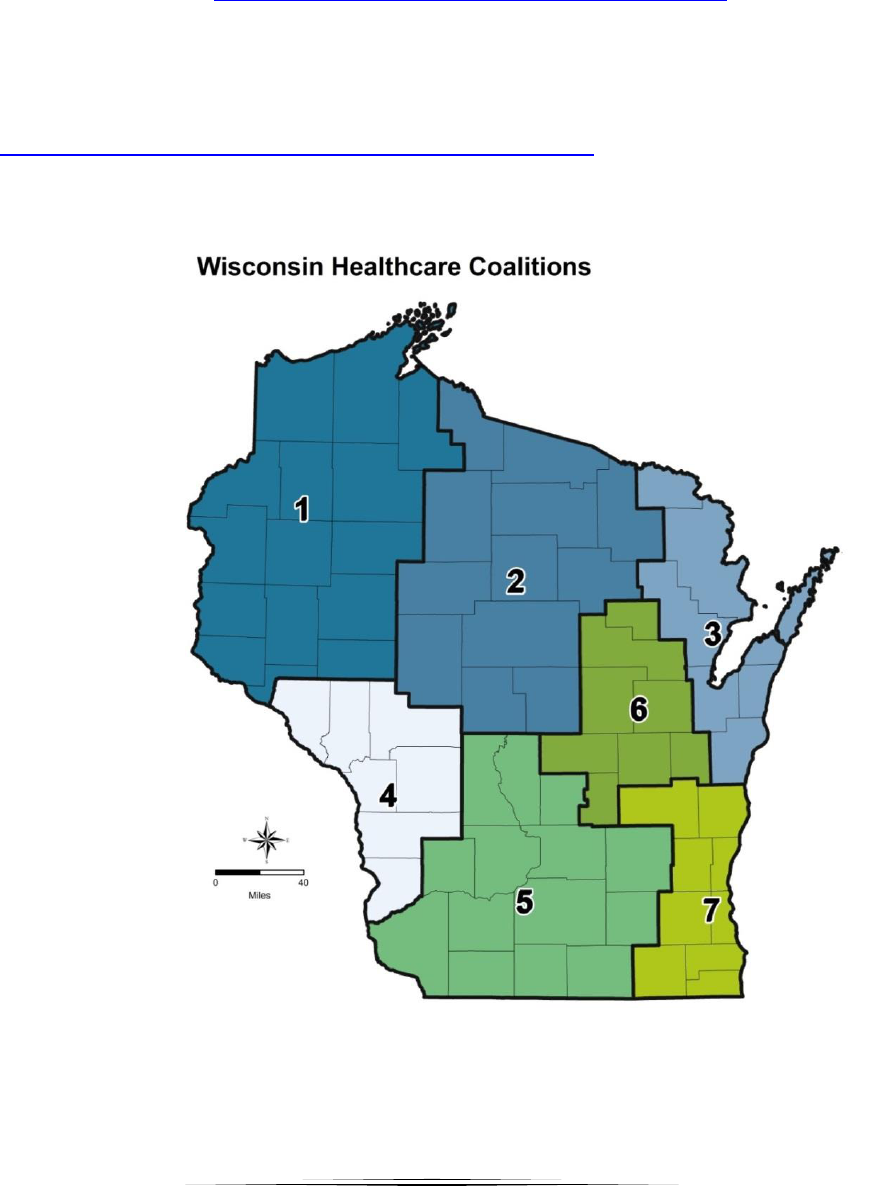
CMS EMERGENCY PREPAREDNESS RULE TOOLKIT:
LONG-TERM CARE: NURSING/SKILLED NURSING FACILITIES
P-01948A
Updated: 6/2020
CONTENTS
WELCOME .................................................................................................................................................................. 3
Wisconsin’s Healthcare Emergency Readiness Coalitions (HERCs) ........................................................................... 4
Overview .................................................................................................................................................................... 5
General Information .............................................................................................................................................. 5
Using This Toolkit ................................................................................................................................................... 6
Risk Assessment and Planning ................................................................................................................................... 7
Risk Assessment ..................................................................................................................................................... 7
Continuity of Operations ....................................................................................................................................... 7
Cooperation and Collaboration ............................................................................................................................. 7
Tools and Templates: Risk Assessment and Planning ............................................................................................ 9
Emergency Preparedness Planning Checklist .................................................................................................... 9
Emergency Preparedness Planning Checklist .................................................................................................. 10
Facility-based HVA ........................................................................................................................................... 10
Emergency Operations Plan Activation ........................................................................................................... 10
Essential Services Roles and Responsibilities .................................................................................................. 11
Collaboration Contact Grid .............................................................................................................................. 12
Policies and Procedures ........................................................................................................................................... 14
Subsistence Needs ............................................................................................................................................... 14
Resident and Staff Tracking ................................................................................................................................. 14
Evacuation and Sheltering in Place ...................................................................................................................... 14
Medical Documentation ...................................................................................................................................... 15
Volunteers ............................................................................................................................................................ 15
Transfer Arrangements ........................................................................................................................................ 15
1135 Waivers ....................................................................................................................................................... 16
Tools and Templates: Policies and Procedures ................................................................................................... 17
Subsistence Needs ........................................................................................................................................... 18
Resident and Staff Tracking ............................................................................................................................. 19
Evacuation and Sheltering in Place .................................................................................................................. 20
Medical Documentation .................................................................................................................................. 21
Health Professions Volunteer Use ................................................................................................................... 22
Sample Transfer Agreement ............................................................................................................................ 22
Sample Memorandum of Understanding ........................................................................................................ 22
1135 Waiver Information................................................................................................................................. 22
Communication Plan ................................................................................................................................................ 24
Contact Information ............................................................................................................................................ 24
Communications .................................................................................................................................................. 24
Release of Information ........................................................................................................................................ 25
LTC Facility Information ....................................................................................................................................... 25
Sharing Emergency Plan Information .................................................................................................................. 25
Tools and Templates: Communication Plan ........................................................................................................ 27
External Contact Information .......................................................................................................................... 28
Staff Contact Information ................................................................................................................................ 29
Residents’ Physicians’ Contact Information .................................................................................................... 30
Volunteer Contact Information ....................................................................................................................... 31
Primary and Alternate Means of Communication ........................................................................................... 32
HIPAA Decision Flowchart................................................................................................................................ 33
LTC Facility Information ................................................................................................................................... 34
Sharing Emergency Plan Information .............................................................................................................. 35
Training and Testing................................................................................................................................................. 36
Training Program ................................................................................................................................................. 36
Testing .................................................................................................................................................................. 36
Tools and Templates: Training and Testing ......................................................................................................... 38
Exercise Design Checklist ................................................................................................................................. 39
Exercise Evaluation Guide ................................................................................................................................ 39
https://www.dhs.wisconsin.gov/preparedness/hospital/blank-exercise-evalguide.doc ............................... 39
After Action Report/Improvement Plan Instructions and Template ............................................................... 39
Additional Requirements ......................................................................................................................................... 41
Emergency and Standby Power Systems ............................................................................................................. 41
Integrated Health Care Systems .......................................................................................................................... 41
Resources ................................................................................................................................................................. 43
Definitions ................................................................................................................................................................ 44
Acronyms ................................................................................................................................................................. 46
Appendices .............................................................................................................................................................. 48
Appendix A: Federal Regulation for LTC Facilities ............................................................................................... 48
Appendix B: Emergency Preparedness Regulations Crosswalk ........................................................................... 49
WELCOME
Welcome to the Emergency Preparedness Rule Toolkit for Long-Term Care: Nursing/Skilled
Nursing Facilities, assembled by the Wisconsin Department of Health Services’ Health Care
Preparedness Program, out of the Office of Preparedness and Emergency Health Care in the
Division of Public Health.
In September 2016, the Centers for Medicare & Medicaid Services (CMS) released a new
emergency preparedness rule for 17 sectors of the U.S. health care system. The new rule
asks the affected provider types to demonstrate that they are doing risk assessments; writing
appropriate plans, policies and procedures; and training and testing their plans with staff and
partners in the community.
One of the resources CMS suggests providers can seek out to assist them are the regional
health emergency readiness coalitions (HERCs). In Wisconsin, we have seven of these
coalitions. The memberships of these coalitions—which include hospitals, emergency medical
services, public health agencies, emergency management agencies, and a range of other
partners—plan, train, and exercise together to be ready to support one another in large-scale
emergencies. We invite you to reach out to your region’s coordinator, if you haven’t already, to
find out more. A map of the regions and a link to the current contact information for their
coordinators can be found on the next page.
Each of these toolkits gives facilities that fall under the new rule an overview of the
requirements for their provider type, as well as some sample templates that can be used in
their planning efforts. In topic areas where there wasn’t a tool or template readily available, the
toolkit offers planning worksheets that feature a list of example questions to help facilities think
through relevant issues that can help them draft their plans and policies.
As you may be aware, the Division of Quality Assurance (DQA, another part of the Wisconsin
Department of Health Services), is the state survey agency that oversees Wisconsin’s
certification process on behalf of CMS. While DQA has provided our staff with information and
background on the CMS rule, our provider toolkits were produced independently and are
intended for advisory purposes only. None of the tools or assistance provided by our office or
the regional healthcare coalitions guarantees any outcome during survey visits. Facilities are
solely responsible for meeting CMS requirements.
We wish you success in your efforts to enhance your readiness to protect your patients,
clients, residents, their families, and your staff during emergency situations, and hope the
contents of this toolkit help you on your way!
Best Wishes,
Dave Rozell
David W. Rozell, MPH
Health Emergency Preparedness Section Chief
Office of Preparedness and Emergency Health Care
Wisconsin Department of Health Services

4
*Effective 11/29/2019
WISCONSIN’S HEALTHCARE EMERGENCY READINESS COALITIONS (HERC)
Below is a map of the regional healthcare emergency readiness coalitions in Wisconsin. Contact information for
coalition staff members is provided in the Healthcare Emergency Readiness Coalition Regional Contact
Information document: https://www.dhs.wisconsin.gov/publications/p02587.pdf. Questions about the federal
regulation for emergency preparedness can be directed to your regional HERC coordinator.
In addition, the Wisconsin Healthcare Emergency Preparedness Program website provides links to regional
websites, answers, and updates on many emergency preparedness topics:
https://www.dhs.wisconsin.gov/preparedness/hospital/index.htm

5
*Effective 11/29/2019
OVERVIEW
On September 16, 2016, the Centers for Medicare and Medicaid Services (CMS) published new federal
regulations that included updated emergency preparedness requirements for providers and suppliers
participating in Medicare and Medicaid. For provider-specific text and a link to the full text regulation, see
Appendix A. These requirements fall under new conditions of participation/conditions for coverage; if these
requirements are not met, providers and suppliers risk citation and consequent loss of Medicare or Medicaid
reimbursement. The regulation went into effect on November 15, 2016, and will be included in any surveys
conducted following November 15, 2017.
NOTE (3.6.19): CMS published an updated Interpretive Guidelines, see Appendix Z, on February 1, 2019.
NOTE (11.8.19): CMS released updated regulatory language as a result of a Burden Reduction Rule published in
the Federal Register on September 30, 2019 and are effective as of November 29, 2019.
Seventeen provider and supplier types receiving Medicare or Medicaid reimbursement are affected by the CMS
emergency preparedness rule. The provider and supplier types are:
ambulatory surgical centers
clinics and rehabilitation agencies, and
public health agencies as providers of
outpatient physical therapy and speech-
language pathology services
community mental health centers
comprehensive outpatient rehabilitation
facilities
critical access hospitals
end-stage renal disease facilities
home health agencies
hospices (inpatient and outpatient)
hospitals
intermediate care facilities for individuals
with intellectual disabilities
long term care (skilled nursing facilities)
organ procurement organizations
programs of all inclusive care for the elderly
psychiatric residential treatment facilities
religious nonmedical health care
institutions
rural health clinics and federally qualified
health clinics
transplant centers
The regulation requires affected providers and suppliers to comply with all applicable federal, state, and local
emergency preparedness requirements. The regulation also requires providers and suppliers to develop and
maintain a comprehensive emergency preparedness program, utilizing an all-hazards approach that includes,
but is not limited to, the following domains:
Risk Assessment and Planning: Develop an emergency preparedness plan based on facility and community
risk assessments and utilizing an all-hazards approach; address patient populations, services offered for
continuity of operations, and succession plans.
Policies and Procedures: Develop emergency preparedness policies and procedures based on the risk
assessment, emergency plan, and communication plan; address subsistence needs, patient tracking,
evacuation, sheltering in place, protection of medical documentation, and arrangements with other
providers in the event of patient transfer.
General Information

6
*Effective 11/29/2019
Communication Plan: Develop an emergency preparedness communication plan that complies with federal,
state, and local laws; include contact information for relevant partners, methods to share protected patient
information, and primary and alternate means of communication.
Training and Testing: Develop an emergency preparedness training and testing program based on the risk
assessment, emergency plan, and communication plan; provide annual training on all emergency
preparedness policies and procedures; participate annually in two exercises, one of which must be a full-
scale community-based exercise.
A number of the CMS regulations line up with current accreditation standards for various accrediting bodies. A
crosswalk for the rule and current accreditation standards can be found in Appendix B: Emergency Preparedness
Regulations Crosswalk.
This toolkit provides information on the CMS Emergency Preparedness rule for nursing facilities and skilled
nursing facilities (LTC facilities). There are four major content sections: risk assessment and planning, policies
and procedures, communication plan, and training and testing. The content sections contain detailed
information about the given portion of the rule.
At the end of each of the four content sections, there is a subsection titled Tools and Templates. The Tools and
Templates subsection contains relevant tools, templates, and resources for the given section. These tools,
templates, and resources are mentioned in the content portion of each section, and are linked to the tools and
templates subsection for further explanation and provision.
The parts of the document that follow the four content sections include: additional requirements that may be
applicable to the provider type; pertinent resources; definitions; acronyms; and the appendices.
Using This Toolkit

7
*Effective 11/29/2019
RISK ASSESSMENT AND PLANNING
Long-term care (LTC) facilities should develop and maintain an emergency preparedness plan that is reviewed
and updated at least annually. A checklist that can help LTC facilities in emergency preparedness planning can be
found here: Emergency Preparedness Planning Checklist. LTC facilities should have an emergency plan that
includes, at the least, the following elements:
LTC facilities should base their emergency plan on documented facility-based and community-based risk
assessments, using an all-hazards approach, including addressing a scenario involving missing residents. An all-
hazards approach focuses on developing the capacities and capabilities that support preparedness for a
spectrum of emergencies. All-hazards planning does not address any specific potential threat, but promotes a
facility’s readiness to respond to a broad range of applicable emergencies. Facilities may use community-based
risk assessments developed by other entities, but should have a copy of the risk assessment and ensure their
emergency plan is in alignment with the community-based risk assessment. Additionally, the emergency plan
should include strategies to address the emergencies identified by the risk assessments.
One source of community-based risk assessments is a facility’s Healthcare Emergency Readiness Coalition:
Wisconsin’s Healthcare Coalitions. A template for conducting a Facility-based Hazard Vulnerability Assessment
(HVA).
LTC facility emergency plans should address their resident population, including at-risk residents; services
provided in emergencies; and continuity of operations, including delegations of authority and succession plans.
LTC facilities need to identify and plan for residents who may require additional assistance. Additionally, LTC
facilities should identify staff roles as necessitated by the emergency, through succession planning and clear
delegations of authority. At the least, LTC facilities should identify a qualified individual who is authorized in
writing to act in the absence of the administrator or person legally responsible for the operations of the facility.
Continuity of operations plans should include facility- and community-based risk assessments and identify
essential personnel, essential functions, and critical resources. These plans should also describe how the facility
will protect vital records and IT data, as well as identify and locate alternate facilities and financial resources as
needed.
Examples of useful continuity of operations tools include:
Emergency Operations Plan Activation
Essential Services Roles and Responsibilities
In the development of an emergency plan, LTC facilities should include a process for cooperation with local,
tribal, regional, state, and federal emergency preparedness officials. Collaboration with these officials will
Risk Assessment
Continuity of Operations
Cooperation and Collaboration

8
*Effective 11/29/2019
encourage integrated responses during emergency situations. LTC facilities are no longer* required to include
documentation of their efforts to contact such officials. However, when LTC facilities are able to participate in
cooperative planning efforts, documentation of that participation is recommended.
The Collaboration Contact Grid provides a template for documenting emergency preparedness contacts.

9
*Effective 11/29/2019
This section contains tools, templates, and resources that may be helpful for risk assessment and planning.
Included are the:
Emergency Preparedness Planning Checklist
Facility-based HVA
Emergency Operations Plan Activation
Essential Services Roles and Responsibilities
Collaboration Contact Grid
Tools and Templates: Risk Assessment and Planning

10
*Effective 11/29/2019
Emergency Preparedness Planning Checklist
The Emergency Preparedness Checklist is located on the CMS Survey and Certification website. This checklist can
help LTC facilities in emergency preparedness planning. The checklist reviews major topics that emergency
preparedness programs should address, and provides information on details related to those topics. This can be
an important tool for tracking progress on creating an emergency preparedness plan.
https://www.cms.gov/Medicare/Provider-Enrollment-and-
Certification/SurveyCertEmergPrep/Downloads/SandC_EPChecklist_SA.pdf
Facility-based HVA
HVAs are a systematic approach to identifying potential hazards that might affect an organization. Vulnerability
is determined by assessing risk associated with each hazard and analyzing assessment findings to create a
prioritized comparison of hazard vulnerabilities. The vulnerability is related to both the impact on organizational
and community function and the likely demands the hazard would create. The tools at this website can be used
to conduct a facility-based hazard vulnerability assessment for LTC facilities.
https://www.dhs.wisconsin.gov/regulations/preparedness/prep-hva.htm
Emergency Operations Plan Activation
The following grid is an example of the type of tool LTC facilities may create to document a chain of
responsibility for activating emergency operations plans. Individuals selected would be responsible for assessing
emergent situations and activating the emergency operations plan when appropriate.
Individuals Responsible for Emergency Operations Plan Activation
Name
Contact Number
Primary
Backup 1
Backup 2

11
*Effective 11/29/2019
Essential Services Roles and Responsibilities
This grid is a example of a tool LTC facilities may create to track roles and responsibilities for essential services
during emergency events. Services identified should be essential during emergencies. Roles and responsibilities
for identified services should be clearly stated, and individuals providing these services should be aware of their
responsibilities. A primary and secondary point of contact should be established for each service, so that in the
case of an emergency, the service can be activated and coordinated appropriately.
Roles and Responsibilities
Essential Services
Roles and
Responsibilities
Point of Contact
Secondary Point of
Contact
Administration
Dietary
Housekeeping
Maintenance
Nursing
Pharmacy
Safety and Security
(Additional Services if
Needed)

12
*Effective 11/29/2019
Collaboration Contact Grid
The following grid can be completed and retained for the purpose of collaborating with appropriate local, tribal,
regional, state, and federal emergency preparedness partners. These contacts can be resources during
emergency preparedness program development and evaluation, and during real-world emergencies. Using an
all-hazards approach to emergency preparedness, LTC facilities should have the ability to communicate with all
relevant partners, if necessary. However, during an emergency, facilities should prioritize communication with
those entities with an immediate response role such as local public health, local emergency management, and
their regional healthcare coalition.
Emergency Preparedness Contacts
Level
Description
Contact Name
Phone
Email
Local Public Health
Local Emergency
Management
Tribal
Regional:
Healthcare
Emergency
Readiness Coalition
(HERC)
HERC
Coordinator
State:
Division of Quality
Assurance
Contact the
appropriate
BNHRC
regional office.
Juli Brandt/SRO
Daniel Perron /NERO
Carol Jean
Rucker/SERO
Tammy Modl /WRO
Jessica Radtke /NRO
608-266-9422 (JB)
920-448-5240 (DP)
414-227-4563
(CJR)
715-836-3030
(TM)
715-365-2801 (JR)
juli.brandt@dhs.wisconsin.gov
daniel.Perron@dhs.wisconsin.gov
caroljean.rucker@dhs.wisconsin.gov
[email protected]sin.gov
jessica.radtke@dhs.wisconsin.gov
State: Office of
Emergency
Preparedness and
Health Care
DHS 24-hour
Emergency
Hotline
On Call
608-258-0099
NA
Federal: CMS
CMS Region 5
Emergency
Coordinator
CMS Region 5
Emergency
Preparedness
Rule POC
Primary: Justin Pak
Secondary: Gregory
Hann
Secondary: 312-
886-5351

14
*Effective 11/29/2019
POLICIES AND PROCEDURES
LTC facilities should develop and implement emergency preparedness policies and procedures that are based on
their risk assessment, emergency plan, and communication plan. These policies and procedures should be
reviewed and updated at least annually. LTC facilities may choose whether to incorporate emergency policies
and procedures into their emergency plan or to include policies and procedures into their standard operating
procedures/operations manual. However, the emergency plan and policies and procedures should always be
easily accessible, and it is recommended that they be co-located.
At a minimum, the emergency preparedness policies and procedures for LTC facilities should address the
following elements:
LTC facility policies and procedures should address the subsistence needs for staff and residents, including
procedures for evacuation or sheltering in place. Subsistence needs may include, but are not limited to:
Food, water, medical, and pharmaceutical supplies.
Alternate sources of energy to maintain appropriate temperatures, emergency lighting, fire response, and
sewage/waste management.
There are no set requirements for the amount of provisions that must be stored by LTC facilities. LTC facilities
should make appropriate needs assessments based on their risk assessments and the potential services,
including community sheltering, they may provide in emergency events.
The Subsistence Needs worksheet provides questions to consider for subsistence needs policies and procedures.
LTC facilities should develop policies and procedures that outline a system to track on-duty staff and sheltered
residents that are in the LTC facility’s care both during and after an emergency. Tracking should include the
location of on-duty staff and sheltered residents, including the name and location of the receiving
facility/destination in the event of relocation. Information should be readily available, accurate, and shareable
among officials.
The Resident and Staff Tracking worksheet provides questions to consider for resident and staff tracking policies
and procedures.
Emergency preparedness policies and procedures should include processes for safe evacuation from the LTC
facility. Evacuation procedures should consider the treatment needs of evacuating residents, evacuation
protocols for any other individuals sheltered in the LTC facility, responsibilities held by staff members,
transportation of residents, identification of evacuation location(s), and primary and alternate means of
Subsistence Needs
Resident and Staff Tracking
Evacuation and Sheltering in Place

15
*Effective 11/29/2019
communication with external sources of assistance. LTC facilities should consider developing triaging systems to
prioritize resident evacuation if the need arises.
In certain situations, evacuation of the LTC facilities may not be appropriate or possible. For these situations, as
identified by the facility’s risk assessment, LTC facilities should develop policies and procedures for sheltering in
place. LTC facilities should develop criteria for which residents and staff would shelter in place, and identify
appropriate facilities to accept residents that are transferred. Facilities should determine their policies based on
the type of emergency and the types of residents, staff, volunteers, and visitors that may be on site during an
emergency.
The Evacuation and Sheltering in Place worksheet provides questions to consider for evacuation and sheltering
in place policies.
Emergency policies and procedures should include a system of medical documentation that is readily available
while protecting the confidentiality of resident information. The system of medical documentation should
support continuity of care, whether in the affected LTC facility or in a receiving facility, in the event the resident
is transferred. These policies and procedures should supplement existing medical record requirements and
regulations. These policies and procedures should also be in compliance with the Health Insurance Portability
and Accountability Act (HIPAA).
The Medical Documentation worksheet provides questions to consider for medical documentation policies and
procedures.
LTC facility policies and procedures should address emergency staffing strategies, including the use of facility
volunteers and state and federally designated health care professionals, in the event of surge needs. LTC
facilities may consider utilizing the Wisconsin Emergency Assistance Volunteer Registry (WEAVR) (more
information is in the Health Professions Volunteer Use section) to recruit volunteers to meet medical surge
needs. LTC facilities should consider any essential privileging and credentialing processes that may become
relevant in emergency situations. Policies and procedures should also include a method for contacting off-duty
staff or addressing staffing shortages caused by inability of staff to report to work.
LTC facility policies and procedures should include prearranged transfer agreements with other LTC facilities and
providers to receive residents in the event of limitations or cessations of operations. These agreements may be
written or contracted. Policies and procedures should also include pre-arranged transportation between
facilities. The goal of such agreements should be continuity of care for residents.
Example agreements include:
Medical Documentation
Volunteers
Transfer Arrangements

16
*Effective 11/29/2019
Sample Transfer Agreement
Sample Memorandum of Understanding
The LTC facility’s policies and procedures should include the role of the LTC facility in providing care and
treatment at alternate sites in the event of the declaration of an 1135 waiver (a link to more information is
provided below). LTC facilities should collaborate with local emergency officials to organize a systemic response
that ensures continuity of care even when services at their facility are severely disrupted. Policies and
procedures should also address the LTC facility’s role in emergencies in which the President declares a major
disaster or emergency and the United States Health and Human Services (HHS) Secretary declares a public
health emergency. Additionally, policies and procedures should address the coordination efforts required during
a declared emergency in which an 1135 waiver has been granted, and should outline the responsibilities of the
LTC facility during the waiver period.
For purposes of waiver or modification, an emergency area and period is where and when there is: a) an
emergency or disaster declared by the President pursuant to the National Emergencies Act or the Stafford Act,
and b) a public health emergency declared by the HHS Secretary.
The CMS regional office in Chicago reviews requests for Social Security Act Chapter 1135 waivers following an
emergency declaration or confirmation by the State (Public) Health Officer. Requests are first submitted to the
Division of Quality Assurance for review in advance of submission to the Chicago Regional Office.
1135 waiver contact for Wisconsin:
Nikki Andrews, Director
DQA Bureau of Education Services and Technology
Telephone: 608-266-2055
Email: Nikki.Andre[email protected]ov
See the 1135 Waiver Information section for more information.
1135 Waivers

17
*Effective 11/29/2019
This section contains tools, templates, and resources that may be helpful for policies and procedures for the
following subjects:
Subsistence Needs
Resident and Staff Tracking
Evacuation and Sheltering in Place
Medical Documentation
Health Professions Volunteer Use
Sample Transfer Agreement
Sample Memorandum of Understanding
1135 Waiver Information
Tools and Templates: Policies and Procedures

18
*Effective 11/29/2019
Subsistence Needs
Below are some questions to consider when developing policies and procedures pertaining to subsistence
needs. These questions are not exhaustive; instead, they are intended to initiate and facilitate a conversation
around necessary aspects of the policies and procedures.
How many residents does your facility have on-site, on average?
How many staff members does your facility have on-site, on average?
How many visitors does your facility have on-site, on average?
How long would you plan to sustain shelter-in-place?
What supplies, in what quantities, would you need to shelter in place over a 24-hour period for each of the
following categories?
o Food
o Water (potable)
o Water (non-potable)
o Medical (gowns, gloves, bedding, tubing, syringes, oxygen tanks, medical gas, etc.)
o Pharmaceutical
o Alternate sources of energy (maintain appropriate temperatures, emergency lighting, fire response, and
sewage waste management)
Where would you stockpile these inventories?
Who is responsible for maintaining these emergency inventories?
How would you access / distribute these supplies during an emergency?
Where would you get additional supplies when your inventories begin to run low?

19
*Effective 11/29/2019
Resident and Staff Tracking
Below are some questions to consider when developing policies and procedures pertaining to resident and staff
tracking. These questions are not exhaustive; instead, they are intended to initiate and facilitate a conversation
around necessary aspects of the policies and procedures.
How will the facility track the name and location of residents during an emergency? (This includes residents
who are sheltered in the facility, as well as residents transferred to other locations during an evacuation.)
How will the facility track the name and location of on-duty staff during an emergency?
Would these tracking policies and procedures differ during an emergency versus after an emergency?
If the means of tracking staff and residents is electronically-based, how would this be accomplished if such
systems were compromised (e.g., power outage, cyberattack, etc.)?
How is this information maintained during the emergency?
How often is it updated?
Which staff members are responsible for accomplishing these tasks?
How could this information be accessible and shared with partners upon request?

20
*Effective 11/29/2019
Evacuation and Sheltering in Place
Below are some questions to consider when developing policies and procedures pertaining to evacuation and
sheltering in place. These questions are not exhaustive; instead, they are intended to initiate and facilitate a
conversation around necessary aspects of the policies and procedures.
What criteria are used to determine whether the facility will shelter in place or evacuate during an
emergency?
Who has decision-making authority to make this determination?
What procedures will the facility use to determine which residents can be discharged versus moved to
another facility?
What procedures will the facility use to determine the order in which residents are evacuated?
How will the treatment needs of residents be identified and addressed during evacuations?
What evacuation procedures will be used for non-residents, e.g., staff and visitors?
Which staff members have what responsibilities during the execution of evacuation procedures?
How will transport of residents be arranged?
How will you identify appropriate facilities to receive residents?
How will facilities ensure that primary and alternate means of communicating with external partners about
evacuation are in place?

21
*Effective 11/29/2019
Medical Documentation
Below are some questions to consider when developing policies and procedures pertaining to medical
documentation. These questions are not exhaustive; instead, they are intended to initiate and facilitate a
conversation around necessary aspects of the policies and procedures.
What systems/policies/procedures exist to provide resident medical documentation on a day-to-day basis?
Are there changes to these systems/policies/procedures in an emergency?
How would medical documentation be transferred during an evacuation to accompany a resident to a
receiving facility?
How are standards of confidentiality maintained?
Where are these existing policies/procedures documented for the facility? Think about policies that have
been developed to maintain compliance with HIPAA, Joint Commission, local and state law, etc.
If electronic medical records are used, what redundant processes exist in case such systems are
compromised (power outages, cyberattacks, etc.)?
Who is responsible for activating redundant systems?

22
*Effective 11/29/2019
Health Professions Volunteer Use
WEAVR is the Wisconsin Emergency Assistance Volunteer Registry. WEAVR is a secure, web-based volunteer
registration system for health care and behavioral health professionals. In an emergency, facilities can request
that state public health officials send out a WEAVR request. Public health officials will identify appropriate
individuals and contact potential volunteers. Volunteers who agree to help will be dispatched to the LTC facility’s
location and informed of the role they need to fill. LTC facilities should understand how to use WEAVR before
emergency situations arise. More information about WEAVR can be found on the DHS’ WEAVR web-page:
https://www.dhs.wisconsin.gov/preparedness/weavr/index.htm
Sample Transfer Agreement
The Sample Transfer Agreement document (linked below) provides a template transfer agreement for LTC
facilities. LTC facilities can use this template or build their own based on this example. The transferring LTC
facility and receiving facility both complete and sign this form prior to emergency events, so that in an
emergency situation in which residents need to be transferred from the affected LTC facility, a transfer
agreement is already in place. The document outlines expectations between the facilities and the terms of
agreement.
https://www.cms.gov/Medicare/Provider-Enrollment-and-
Certification/SurveyCertEmergPrep/Downloads/Facility-Transfer-Agreement-Example.pdf
Sample Memorandum of Understanding
The Sample Memorandum of Understanding document, P-00690 (linked below), provides a template for
Memorandums of Understanding (MOU) along with guidance on completing the MOUs. MOUs are used to
establish a mutual understanding of the roles and responsibilities of participating entities during an emergency
incident. MOUs include the scope of services to be provided and reimbursement considerations. MOUs should
be developed before emergency situations, so that in emergency events, a clear set of expectations exists
between involved entities. There are three templates included in this document: one for like-type facilities, one
for community partners/non-like-type facilities, and one for transportation services.
https://www.dhs.wisconsin.gov/publications/p0/p00690.pdf
1135 Waiver Information
When the President of the United States declares an emergency under the Stafford Act or National Emergencies
Act, and the Health and Human Services Secretary declares a public health emergency under Section 319 of the
Public Health Service Act, the Secretary is allowed to assume additional actions on top of their usual authorities.
One of these actions is to waive or modify certain Medicare, Medicaid, and Children’s Health Insurance Program
requirements, under section 1135 of the Social Security Act, to ensure that sufficient health care services are
available to meet the needs of affected populations. The 1135 waivers may include adjustments to the

23
*Effective 11/29/2019
conditions of participation or other certification requirements. Once an 1135 waiver is authorized at the federal
level, LTC facilities can submit requests to their State Survey Agency (DQA) to operate under the authority of the
waiver. LTC facilities should justify the use of the waiver, the expected modifications to usual standards, and the
duration of the waiver use. The 1135 Waiver-At-A-Glance document (linked below) provides more detail on
what 1135 waivers are, and when and how they may be implemented.
https://www.cms.gov/Medicare/Provider-Enrollment-and-
Certification/SurveyCertEmergPrep/Downloads/1135-Waivers-At-A-Glance.pdf

24
*Effective 11/29/2019
COMMUNICATION PLAN
LTC facilities should develop and maintain an emergency preparedness communication plan that complies with
federal, state, and local laws. This communication plan should be reviewed and updated at least annually. The
communication plan should include how the facility coordinates resident care within the facility, across health
care providers, and with state and local public health departments. The communication plan should also include
how the facility interacts and coordinates with emergency management agencies and systems to protect
residents.
The communication plan should include the elements described in the sections below.
The communication plan should include both names and contact information for the following internal assets of
the facility:
Staff
Entities providing services under arrangement
Residents’ physicians
Other LTC facilities
Volunteers
The communication plan should also include contact information for the following external resources:
Federal, state, tribal, regional, and local emergency preparedness staff
The State Licensing and Certification Agency
The Office of the State Long-Term Care Ombudsman
Other identified sources of assistance
Contact information should be readily available and accessible to leadership and staff. All contact information
should be accurate and current.
Sample contact grids are included for the following contact types:
External Contact Information
Staff Contact Information
Residents’ Physicians’ Contact Information
Volunteer Contact Information
The LTC facility’s communications plans should include primary and alternate means for communicating with
their staff and federal, state, tribal, regional, and local emergency management agencies. The communication
plan should include when and how alternate communication methods are used and who uses them.
Additionally, LTC facilities should ensure that their selected alternate method of communication is compatible
with the communication systems of those they need to contact.
Contact Information
Communications

25
*Effective 11/29/2019
A sample grid for documenting primary and alternate means of communications can be found here: Primary and
Alternate Means of Communication.
Communications plans should include methods for a number of information sharing needs. LTC facilities should
develop a method for sharing resident information and medical documentation with other providers to maintain
continuity of care. Information necessary to provide resident care should be sent with evacuated residents or be
readily available for residents who are sheltered in place. When residents are transferred, LTC facilities should
send all necessary resident information that is readily available, including resident name, date of birth, allergies,
current medications, medical diagnoses, blood type, advance directives, and next of kin/emergency contacts.
LTC facilities should have HIPAA-compliant means to release resident information to family members and others
in a timely and accurate fashion, in the event of an evacuation. Additionally, LTC facilities should develop HIPAA-
compliant means of providing general information about the condition and location of residents that are in the
LTC facility’s care. Though HIPAA requirements are not suspended during a national or public health emergency,
the privacy rule does permit certain uses and disclosures of protected health information in emergency
circumstances and for disaster relief purposes.
A decision flowchart for disclosing protected health information can be found in the HIPAA Decision Flowchart.
LTC facility communication plans should include a means for providing information on the LTC facility’s
occupancy, needs, and ability to provide assistance to others. Occupancy information may include reporting the
number of residents at the LTC facility receiving treatment or the LTC facility’s occupancy percentage. An LTC
facility’s reported needs may include shortage of provisions, assistance with evacuation, or
transportation/transfer shortages. The communication plan should specifically include how the required
information would be communicated.
This information should be provided to the authority with jurisdiction. The authority with jurisdiction varies by
local, state, and federal emergency management structures as well as the nature of the emergency.
LTC facilities can develop a communication plan for conveying LTC facility information using the questions to
consider found in the LTC Facility Information section.
LTC facility communication plans should include a method for sharing information from the emergency plan with
residents and their families or representatives. LTC facilities have the flexibility to determine the information
from the emergency plan that should be shared, as well as the timing and manner in which it should be
disseminated. This dissemination of information should be provided well before emergency events, so that
residents and their families are aware of emergency procedures in their LTC facility. LTC facilities may want to
Release of Information
LTC Facility Information
Sharing Emergency Plan Information

26
*Effective 11/29/2019
provide a quick “fact sheet” or informational brochure that highlights the major sections of the emergency plan
and policies and procedures, as the facility deems appropriate. LTC facilities may also consider providing
instructions on how to contact the facility in the event of an emergency.
A worksheet with questions to consider for sharing emergency plan information can be found in the Sharing
Emergency Plan Information section.

27
*Effective 11/29/2019
This section contains tools, templates, and resources that may be helpful for communication plans:
External Contact Information
Staff Contact Information
Residents’ Physicians’ Contact Information
Volunteer Contact Information
Primary and Alternate Means of Communication
HIPAA Decision Flowchart
LTC Facility Information
Sharing Emergency Plan Information
Tools and Templates: Communication Plan

28
*Effective 11/29/2019
External Contact Information
This grid is an example of the type of tool LTC facilities may create to maintain information for external contacts.
LTC facilities should keep contact information updated so that in an emergency event, the appropriate individual
can be reached in a timely fashion. The purpose for reaching out to a given contact should be included, so it is
clear who should be contacted for what reason in any given situation.
External Contacts
Agency
Purpose for Contact
Contact Name/Title
Contact Info
Local Emergency Management
Staff
Local Public Health Department
Healthcare Emergency Readiness
Coalition (HERC)
State Emergency Management
Staff
State Public Health Department
(Emergency Preparedness )
State Public Health Department
(Division of Quality Assurance)
Tribal Emergency
Preparedness/Emergency
Management
CMS
ASPR
FEMA
State Licensing and Certification
Agency
Office of the State Long-Term
Care Ombudsman
Fire
EMS
Police
Sheriff
Coroner
Other LTC Facility(ies)
Other Facilities w/ MOUs
Entities Providing Services
Sister Facilities
(Additional Sources of Assistance)

29
*Effective 11/29/2019
Staff Contact Information
This grid is an example of the type of tool LTC facilities may create to maintain contact information for staff. LTC
facilities should be able to contact staff during emergencies. Reasons for contact may include cancelling shifts,
determining which staff are actually on duty or on site, or reaching out to staff to help with surge needs. It
should be decided whether roles for staff will be adjusted or increased during emergency events, and if so, those
roles should be clarified and documented.
Staff Emergency Contact Roster
Name
Department
Phone
Email Address
Emergency
Staffing Role

30
*Effective 11/29/2019
Residents’ Physicians’ Contact Information
This grid is an example of the type of tool LTC facilities may create to maintain contact information for their
residents’ physicians. LTC facilities should be able to contact residents’ physicians in a timely manner during
emergency events. LTC facilities should maintain updated contact information for physicians and include
multiple ways to reach their residents’ physicians.
Resident Physician Emergency Contact Roster
Name
Department
Phone
Pager
Email Address

31
*Effective 11/29/2019
Volunteer Contact Information
This grid is an example of the type of tool LTC facilities may create to maintain contact information for
volunteers. LTC facilities should be able to contact volunteers during emergencies. Reasons for contact may
include cancelling shifts, determining which volunteers are actually on duty or on site, or reaching out to
volunteers to help with surge needs. It should be decided whether roles for volunteers will be adjusted or
increased during emergency events, and if so, those roles should be clarified and documented.
Volunteer Emergency Contact Roster
Name
Department
Phone
Email Address
Emergency
Staffing Role

32
*Effective 11/29/2019
Primary and Alternate Means of Communication
This grid is an example of the type of tool LTC facilities may create to document primary and alternate means of
communication with relevant individuals/partners. LTC facilities should have at least two methods of
communicating with staff and relevant partners. The alternate method should be easily accessible, in the event
that the primary method becomes unavailable, and should be agreeable to both the LTC facility and the entity
they are communicating with. Primary and alternate methods of communication may vary based on who the LTC
facility is trying to contact (for example, primary and alternate methods of communication may be different for
staff than they are for state emergency management staff), but should be decided and documented before
emergency events occur so that communication expectations are clear in emergency events.
Means of Communication
Contact
Primary Method
Alternate Method
Staff
Local Emergency Management
Staff
Local Public Health Department
Healthcare Emergency Readiness
Coalition (HERC)
State Emergency Management
Staff
State Public Health Department
(Emergency Preparedness)
State Public Health Department
(Division of Quality Assurance)
Tribal Emergency Preparedness/
Emergency Management Staff
CMS
ASPR
FEMA

33
*Effective 11/29/2019
HIPAA Decision Flowchart
HIPAA is not waived in emergency events, LTC facilities should be aware of the need to protect resident
information at all times. However, certain information can be shared during emergency events if the protected
health information is disclosed for public health emergency preparedness purposes. The At-A-Glance Disclosure
Decision Flowchart (linked below) can help LTC facilities make choices about disclosing protected health
information. If there is uncertainty about the appropriateness of disclosing information, LTC facilities should err
on the side of caution or contact appropriate authorities for guidance.
https://www.cms.gov/Medicare/Provider-Enrollment-and-Certification/SurveyCertEmergPrep/Downloads/OCR-
Emergency-Prep-HIPPA-Disclose.pdf

34
*Effective 11/29/2019
LTC Facility Information
Below are some questions to consider when developing communication plans pertaining to sharing LTC facility
information. These questions are not exhaustive; instead, they are intended to initiate and facilitate a
conversation around necessary aspects of the communication plan.
How does the facility determine which authorities to notify in the event of an emergency?
How do the authorities vary in different types of emergency situations?
How are occupancy levels communicated to local and state authorities during an emergency?
How are supply and other needs communicated to local and state authorities during an emergency?
How does the facility convey to local and state authorities their ability to help others?
How might the means of communication differ depending on the emergency or the authorities being
notified?
What redundant means of communication exist for providing this information?

35
*Effective 11/29/2019
Sharing Emergency Plan Information
Below are some questions to consider when developing communication plans pertaining to sharing emergency
plan information. These questions are not exhaustive; instead, they are intended to initiate and facilitate a
conversation around necessary aspects of the communication plan.
What information from the emergency plan will be shared with residents and families/representatives?
Who will make the decision about the type of information provided?
In what format will this information be provided (e.g., fact sheet, brochure, website)?
Will the information be reviewed with residents and families/representatives?
When will this information be provided to residents and families?
Is there a system for reissuing this information when it is updated?

36
*Effective 11/29/2019
TRAINING AND TESTING
The LTC facility should develop and maintain an emergency preparedness training and testing program that is
based on the risk assessments, emergency plan, policies and procedures, and communication plan. The training
and testing program should be reviewed and updated at least annually.
Training should encompass the LTC facility’s provision of education and instruction to staff, contractors, and
facility volunteers. Testing should operationalize training, and allow the LTC facility to evaluate the effectiveness
of their training as well as the overall emergency preparedness program. Testing can include conducting drills
and/or exercises to test the emergency plan and identify gaps or areas for improvement.
Training and testing can include, but is not limited to, how the LTC facility would communicate facility closure to
required contacts, testing resident tracking, or testing transportation procedures. For LTC facilities with multiple
locations, the training and testing program should reflect the facility-based risk assessment for each specific
location.
LTC facilities should develop training programs that cover emergency preparedness policies and procedures. This
training should be available during orientation for all new staff, individuals providing services under
arrangement, and volunteers, and be consistent with their expected role in an emergency. Existing staff should
also receive emergency preparedness training at least annually. Ideally, this annual training should be modified
each year to reflect lessons learned from exercises and real world events in the past year and the annual
emergency program review. Though all staff should receive annual training, LTC facilities can decide what level
of training each staff member should complete each year, based on their expected responsibilities in an
emergency. LTC facilities may also determine that documented external training is sufficient to meet some or all
of the LTC facility’s annual training requirements.
All emergency preparedness training* should be documented and LTC facilities should be able to demonstrate
staff knowledge of emergency preparedness program plans, policies, and procedures. This documentation
should include the specific training completed as well as the methods used to demonstrate knowledge of the
training program.
LTC facilities must conduct exercises to test the emergency plan at least twice* annually. LTC facilities must:
I. Participate in an annual full-scale exercise that is community based*; or
a. When a community based exercise is not accessible, conduct an individual facility based functional*
exercise; or
b. If the LTC facility experiences a natural or man-made emergency that requires activation of the
emergency plan, the LTC facility is exempt from engaging in its next required full scale community-
based exercise or individual facility-based functional exercise following the onset of the emergency
event.
Training Program
Testing

37
*Effective 11/29/2019
II. Conduct an additional exercise that may include, but is not limited to the following:
a. A second full-scale exercise that is community-based or a facility based functional exercise; or
b. A mock disaster drill; or
c. A tabletop exercise or workshop that is led by a facilitator and includes a group discussion using a
narrated, clinically-relevant emergency scenario, a set of problem statements, directed messages, or
prepared questions designed to challenge an emergency plan.*
III. Analyze the response to and maintain documentation of all drills, tabletop exercises, and emergency
events and revise the ASC’s emergency plan, as needed.*
As required by this rule, full-scale exercises are defined as any operations-based exercise (drill, functional, or
full-scale) that assesses an LTC facility’s operations and its given community. This is an operations-based exercise
that typically involves multiple agencies, jurisdictions, and disciplines performing functional or operational
elements. Full-scale exercises, as defined in this regulation, are not synonymous with full-scale exercises as
defined by FEMA or Department of Homeland Security Exercise and Evaluation Program (HSEEP).
LTC facilities should maintain documentation of all drills, tabletop exercises, and emergency events. LTC facilities
should also analyze their response to testing exercises and real world events, and revise their emergency
program as appropriate. This analysis and revision can, in part, be accomplished through the completion of After
Action Reports (AARs—link provided below). At a minimum, AARs should determine what was supposed to
happen, what occurred, what went well, what the LTC facility can do differently or improve upon, and a plan
with timelines for incorporating necessary improvements.
LTC facilities should consider their physical location, agency, other facility responsibilities, and the needs of the
community when planning or participating in exercises. Often, emergency preparedness entities, such as
healthcare coalitions, may conduct annual, full-scale, community-based exercises to assess community-wide
response. LTC facilities should actively engage the HCCs to identify potential opportunities to participate in
exercises. These exercises give LTC facilities the opportunity to assess their emergency plan, and better
understand how they can contribute to, coordinate with, and integrate into the broader community’s response
during an emergency. They also provide an opportunity to assess communication plans and engagement with
external partners. LTC facilities should contact their HCC to identify opportunities and assess whether
participation in the HCC exercise fulfills the LTC facility’s CMS requirements. HCCs do not have the resources to
fulfill individual LTC facility requirements and consequently only serve to connect LTC facilities to broader
community engagement and coordination. LTC facilities are responsible for ensuring and documenting that their
participation in HCC exercises meets the requirements expected by CMS.
The following tools and templates are included:
Exercise Design Checklist
Exercise Evaluation Guide
After Action Report/Improvement Plan Instructions Template

39
*Effective 11/29/2019
Exercise Design Checklist
The exercise design checklist document linked below provides a sample checklist for designing exercises. The
document leads users through the necessary steps for exercise design and can be used to document the
planning and development of exercises. The first section of the checklist includes consideration of the type of
exercise, the exercise scenario, the main objectives (target capabilities/critical areas) to be evaluated during the
exercise, the levels of activity to be included in the exercise, who will participate in the exercise, which
organizations/agencies will be involved in the exercise, and when the exercise will occur. The second section of
the checklist includes consideration of communications, resources, safety and security, staff roles and
responsibilities, utilities, and resident care. The following sections guide exercise designers through identifying
players’ expected actions, developing a purpose statement, writing the narrative for the exercise, identifying
major and detailed events in chronological order, and completing the after action report and improvement plan.
https://www.dhs.wisconsin.gov/preparedness/hospital/exercise-design-checklist.doc
Exercise Evaluation Guide
The exercise evaluation guide linked below is a blank document. The content and layout can be amended as is
appropriate, but it is designed to help LTC facilities assess their exercises. The guide includes areas for evaluating
numerous activities included in a single exercise. Expected observations can be entered ahead of time. After the
exercise, evaluators can assess whether expectations were observed and the extent to which expectations were
completed or met. LTC facilities can complete this exercise evaluation guide as part of their AAR, to assess areas
of strength and weakness.
https://www.dhs.wisconsin.gov/preparedness/hospital/blank-exercise-evalguide.doc
After Action Report/Improvement Plan Instructions and Template
After action reports and improvement plans (IPs) are important parts of emergency preparedness testing. AARs
help facilities assess their response to emergency events, whether simulated during an exercise, or real-world.
AARs review the exercise design and execution, and provide an assessment of what went well and what needs
to be improved upon. IPs specifically outline how and when improvements will be made to address
shortcomings identified by the exercise evaluation and AAR.
The CMS AAR/IP instructions document walks through developing an AAR and IP. The document includes a
purpose statement and background information on emergency preparedness. Additionally, the document
contains explanations of key terms and important capabilities. It is important to note that this AAR/IP instruction
document is based on the U.S. Department of Homeland Security Exercise and Evaluation Program (HSEEP).
Though LTC facilities may choose to use HSEEP to meet exercise requirements for the CMS rule, it is essential to
understand that the expectations for HSEEP and the CMS rule are not the same in regard to emergency
preparedness testing. LTC facilities should always ensure that their exercises and other testing activities meet
the requirements of the CMS rule.

40
*Effective 11/29/2019
The CMS AAR/IP template document can be used to complete an AAR and IP. The document contains blank
sections with instructions on how to fill out essential components in italics. The template covers the executive
summary, exercise overview, exercise design summary, improvement plan, and conclusion. The template also
contains five appendices: acronyms, lessons learned (optional), participant feedback summary (optional),
exercise events synopsis (optional), and exercise events summary table (optional). LTC facilities may use, modify,
and customize this document as is appropriate for their facility. However, if an LTC facility wishes to conduct an
exercise compliant with the Hospital Preparedness Program (HPP) and HSEEP requirements, the template
sections must not be modified and each section (excluding those marked optional) must be completed entirely.
LTC facilities wishing to ensure compliance with the HPP and HSEEP should assess whether their testing program
meets the CMS rule requirements. If LTC facilities determine they are not meeting conditions of participation
with this template as is, they may consider completing a second AAR/IP that is compliant with the CMS
regulations.
The AAR/IP instructions and template can be found on the CMS Templates and Checlists web-page:
https://www.cms.gov/Medicare/Provider-Enrollment-and-Certification/SurveyCertEmergPrep/Templates-
Checklists.html under the Health Care Provider Voluntary After Action Report/Improvement Plan Template and
Instructions link.
A direct file link is provided here: https://www.cms.gov/Medicare/Provider-Enrollment-and-
Certification/SurveyCertEmergPrep/Downloads/aartemplateinstructions.zip

41
*Effective 11/29/2019
ADDITIONAL REQUIREMENTS
LTC facilities should implement emergency and standby power systems based on their emergency plan and
policies and procedures. The following three components should be addressed:
(a) Emergency generator location. The generator should be located in accordance with the location
requirements found in the Health Care Facilities Code (NFPA 99 and Tentative Interim Amendments TIA
12–2, TIA 12–3, TIA 12–4, TIA 12– 5, and TIA 12–6), Life Safety Code (NFPA 101 and Tentative Interim
Amendments TIA 12–1, TIA 12–2, TIA 12–3, and TIA 12–4), and NFPA 110, when a new structure is built
or when an existing structure or building is renovated.
(b) Emergency generator inspection and testing. The LTC facility should implement the emergency power
system inspection, testing, and maintenance requirements found in the Health Care Facilities Code,
NFPA 110, and Life Safety Code (LSC).
(c) Emergency generator fuel. LTC facilities that maintain an onsite fuel source to power emergency
generators should have a plan for how it will keep emergency power systems operational during the
emergency, unless it evacuates.
LTC facilities should continue to meet the existing provisions and requirements for their provider/supplier types
under physical environment conditions of participation or any existing LSC guidance.
If an LTC facility is part of a health care system consisting of multiple separately certified health care facilities
that elects to have a unified and integrated emergency preparedness program, the LTC facility may choose to
participate in the health care system’s coordinated emergency preparedness program. If elected, the unified
and integrated emergency preparedness program should:
Demonstrate that each separately certified facility within the system actively participated in the
development of the unified and integrated emergency preparedness program.
Be developed and maintained in a manner that takes into account each separately certified facility’s unique
circumstances, resident populations, and services offered.
Demonstrate that each separately certified facility is capable of actively using the unified and integrated
emergency preparedness program and is in compliance with the program.
Include a unified and integrated emergency plan that meets all aforementioned requirements. The unified
and integrated emergency plan should also be based on and include the following:
o A documented community-based risk assessment, utilizing an all-hazards approach.
o A documented individual facility-based risk assessment for each separately certified facility within the
health system, utilizing an all-hazards approach.
Include integrated policies and procedures, a coordinated communication plan, and training and testing
programs that meet the aforementioned requirements.
The health care system’s unified emergency preparedness program should be updated each time a facility leaves
or enters the health care system’s program. The integrated program should demonstrate that each separately
certified facility included in the program actively participated in the program’s development, and each facility
should designate personnel to collaborate with the health care system to develop the plan. This participation
Emergency and Standby Power Systems
Integrated Health Care Systems

42
*Effective 11/29/2019
should be documented. All components of the emergency preparedness program that are reviewed annually
should include all participating facilities, and each facility should be able to prove that it was involved in annual
reviews and updates.

43
*Effective 11/29/2019
RESOURCES
CMS Survey and Certification Website
https://www.cms.gov/Medicare/Provider-Enrollment-and-Certification/SurveyCertEmergPrep/index.html
ASPR TRACIE
https://asprtracie.hhs.gov/cmsrule
https://files.asprtracie.hhs.gov/documents/cms-ep-rule-resources-at-your-fingertips.pdf
Healthcare Emergency Readiness Coalitions
https://www.dhs.wisconsin.gov/preparedness/hospital/index.htm
Regional map and contacts: https://www.dhs.wisconsin.gov/publications/p02587.pdf.
Office of Preparedness and Emergency Health Care (OPEHC), Division of Public Health, Department of Health
Services
https://www.dhs.wisconsin.gov/preparedness/index.htm
Wisconsin Emergency Management (WEM)
https://dma.wi.gov/DMA/wem

44
*Effective 11/29/2019
DEFINITIONS
These definitions reflect those provided by CMS in the Interpretive Guidance for the Emergency Preparedness
regulation.
All-Hazards Approach
An all-hazards approach is an integrated approach to emergency preparedness that focuses on identifying
hazards and developing emergency preparedness capacities and capabilities that can address those as well as a
wide spectrum of emergencies or disasters. This approach includes preparedness for natural, man-made, and or
facility emergencies that may include but is not limited to: care-related emergencies; equipment and power
failures; interruptions in communications, including cyber attacks; loss of a portion or all of a facility; and
interruptions in the normal supply of essentials, such as water and food. All facilities must develop an all-hazards
emergency preparedness program and plan.
Disaster
A hazard impact causing adverse physical, social, psychological, economic, or political effects that challenge the
ability to respond rapidly and effectively. Despite a stepped-up capacity and capability (call-back procedures,
mutual aid, etc.) and change from routine management methods to an incident command/management
process, the outcome is lower than expected compared with a smaller scale or lower magnitude impact (see
“emergency” for important contrast between the two terms).
Reference: Assistant Secretary for Preparedness and Response (ASPR) 2017-2022 Health Care Preparedness and
Response Capabilities Document (ICDRM/GWU Emergency Management Glossary of Terms) (November 2016).
Emergency
A hazard impact causing adverse physical, social, psychological, economic, or political effects that challenge the
ability to respond rapidly and effectively. It requires a stepped-up capacity and capability (call-back procedures,
mutual aid, etc.) to meet the expected outcome and commonly requires change from routine management
methods to an incident command process to achieve the expected outcome (see “disaster” for important
contrast between the two terms).
Reference: Assistant Secretary for Preparedness and Response (ASPR) 2017-2022 Health Care Preparedness and
Response Capabilities Document (ICDRM/GWU Emergency Management Glossary of Terms) (November 2016).
Emergency/Disaster
An event that can affect the facility internally as well as the overall target population or the community at large
or community or a geographic area.
Emergency Plan
An emergency plan provides the framework for the emergency preparedness program. The emergency plan is
developed based on facility- and community-based risk assessments that assist a facility in anticipating and
addressing facility, patient, staff, and community needs and support continuity of business operations.

45
*Effective 11/29/2019
Emergency Preparedness Program
The Emergency Preparedness Program describes a facility’s comprehensive approach to meeting the health,
safety and security needs of the facility, its staff, their patient population, and community prior to, during, and
after an emergency or disaster. The program encompasses four core elements: an emergency plan that is based
on a risk assessment and incorporates an all-hazards approach; policies and procedures; communication plan;
and the training and testing program.
Facility-Based
We consider the term “facility-based” to mean the emergency preparedness program is specific to the facility. It
includes but is not limited to hazards specific to a facility based on its geographic location; dependent
patient/resident/client and community population, facility type, and potential surrounding community assets
i.e., rural area versus a large metropolitan area.
Full-Scale Exercise
A full scale exercise is an operations-based exercise that typically involves multiple agencies, jurisdictions, and
disciplines performing functional (for example, joint field office, emergency operation centers, etc.) and
integration of operational elements involved in the response to a disaster event, i.e., ‘‘boots on the ground’’
response activities (for example, hospital staff treating mock patients).
Risk Assessment
The term risk assessment describes a process facilities use to assess and document potential hazards that are
likely to impact their geographical region, community, facility, and patient population and identify gaps and
challenges that should be considered and addressed in developing the emergency preparedness program. The
term risk assessment is meant to be comprehensive and may include a variety of methods to assess and
document potential hazards and their impacts. The health care industry has also referred to risk assessments as
a hazard vulnerability assessment or analysis (HVA) as a type of risk assessment commonly used in the health
care industry.
Staff
The term "staff" refers to all individuals that are employed directly by a facility. The phrase "individuals
providing services under arrangement" means services furnished under arrangement that are subject to a
written contract conforming with the requirements specified in section 1861(w) of the Act.
Table-top Exercise (TTX)
A tabletop exercise involves key personnel discussing simulated scenarios in an informal setting. TTXs can be
used to assess plans, policies, and procedures. A tabletop exercise is a discussion-based exercise that involves
senior staff, elected or appointed officials, and other key decision-making personnel in a group discussion
centered on a hypothetical scenario. TTXs can be used to assess plans, policies, and procedures without
deploying resources.

46
*Effective 11/29/2019
ACRONYMS
AAR/IP: After Action Report/Improvement Plan
ASC: Ambulatory Surgical Center
ASPR: Assistant Secretary for Preparedness and Response
CAH: Critical Access Hospital
CDC: Centers for Disease Control and Prevention
CfCs: Conditions for Coverage and Conditions for Certification
CMHC: Community Mental Health Center
CMS: Centers for Medicare & Medicaid Services
CoPs: Conditions of Participation
CORF: Comprehensive Outpatient Rehabilitation Facilities
DHS: Department of Homeland Security
DHHS: Department of Health and Human Services
DSA: Donation Service Area
EOP: Emergency Operations Plans
EMP: Emergency Management Plan
EP: Emergency Preparedness
ESAR–VHP: Emergency System for Advance Registration of Volunteer Health Professionals
ESF: Emergency Support Function
ESRD: End-Stage Renal Disease
FEMA: Federal Emergency Management Agency
FQHC: Federally Qualified Health Center
HERC: Healthcare Emergency Readiness Coalition
HHA: Home Health Agencies
HPP: Hospital Preparedness Program
HRSA: Health Resources and Services Administration
HSEEP: Homeland Security Exercise and Evaluation Program
HSPD: Homeland Security Presidential Directive
HVA: Hazard Vulnerability Analysis or Assessment
ICFs/IID: Intermediate Care Facilities for Individuals with Intellectual Disabilities
LPHA: Local Public Health Agencies
LSC: Life Safety Code
LTC: Long-Term Care
NFs: Nursing Facilities
NFPA: National Fire Protection Association
NIMS: National Incident Management System
OPO: Organ Procurement Organization
PACE: Program for the All-Inclusive Care for the Elderly

47
*Effective 11/29/2019
PHEP: Public Health Emergency Preparedness
PRTF: Psychiatric Residential Treatment Facilities
RNHCIs: Religious Nonmedical Health Care Institutions
RHC: Rural Health Clinic
SNF: Skilled Nursing Facility
TJC: The Joint Commission
TRACIE: Technical Resources, Assistance Center, and Information Exchange
TTX: Tabletop Exercise

48
*Effective 11/29/2019
APPENDICES
November 15, 2016
The full text of the federal regulation can be found at:
https://www.federalregister.gov/documents/2016/09/16/2016-21404/medicare-and-medicaid-programs-
emergency-preparedness-requirements-for-medicare-and-medicaid
February 1, 2019:
Appendix Z: Interpretive guidance for the federal regulation can be found at:
https://www.cms.gov/Medicare/Provider-Enrollment-and-
Certification/SurveyCertEmergPrep/Downloads/Advanced-Copy-SOM-Appendix-Z-EP-IGs.pdf
November 29, 2019
Medicare and Medicaid Programs; Regulatory Provisions To Promote Program Efficiency, Transparency, and
Burden Reduction
https://www.federalregister.gov/documents/2019/09/30/2019-20736/medicare-and-medicaid-programs-
regulatory-provisions-to-promote-program-efficiency-transparency-and
Appendix A: Federal Regulation for LTC Facilities

49
*Effective 11/29/2019
This crosswalk was developed by the Yale New Haven Health System Center for Emergency Preparedness and
Disaster Response. This crosswalk is intended to provide a high level reference to standards provided by
accrediting organizations as of January, 2020. This crosswalk does not reflect standards that may have been
updated since then. This crosswalk is not intended to be a comprehensive interpretation of the regulation, but a
reference guide.
Find the crosswalk for Long Term Care: Nursing/Skilled Nursing Facilities on pages 87-94 here:
https://files.constantcontact.com/d901e299001/51f80a78-4ff1-4585-8270-f2aea6d39172.pdf
Appendix B: Emergency Preparedness Regulations Crosswalk


